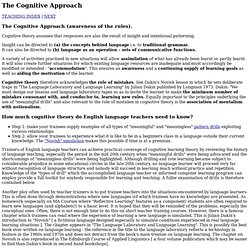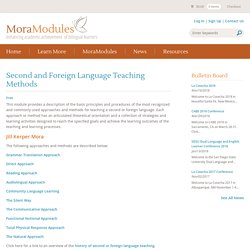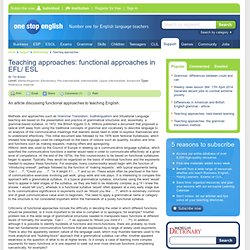

Outlook - pil968. The cognitive approach to language learning and teaching. The Cognitive Approach (awareness of the rules).

Cognitive theory assumes that responses are also the result of insight and intentional patterning. Insight can be directed to (a) the concepts behind language i.e. to traditional grammar. It can also be directed to (b) language as an operation - sets of communicative functions. A variety of activities practised in new situations will allow assimilation of what has already been learnt or partly learnt. It will also create further situations for which existing language resources are inadequate and must accordingly be modified or extended - "accommodation". Cognitive theory therefore acknowledges the role of mistakes. How much cognitive theory do English language teachers need to know? Another ploy often used by teacher trainers is to put trainee teachers into the situations encountered by language learners.
Two Cognitive Approaches to Language Learning ‘ Angl3www_newby_pedagogical_grammar. Tesol methods and materials. Views of Teaching and Learning: Approach, Method, and Technique. 2009-11-30-22-42-42-129-nf1. Noonan - Teaching ESL Students to "Notice" Grammar. The Internet TESL Journal Francis J. Noonan IIIchipperchina [at] hotmail.comEaston Area School District (Easton, PA, USA) This article explains how to teach ESL/EFL students to notice grammar.
There is also a suggested lesson plan. Introduction Many teachers are confused on how to teach grammar. Why Noticing? The theoretical basis for noticing centers around the relationship between explicit and implicit knowledge. The question is can explicit grammar knowledge (Li's knowledge) become implicit knowledge (Jim's knowledge)? What is Noticing? Noticing is basically the idea that if learners pay attention to the form and meaning of certain language structures in input, this will contribute to the internalization of the rule (Batstone, 1996). ". . . we don't actually try to influence the construction of the complex network [implicit knowledge] . . . because really learners can only do it themselves. How Do Teachers Help Students Notice? How can we as teachers help students notice target forms? Second-language Teaching Methods.
This module provides a description of the basic principles and procedures of the most recognized and commonly used approaches and methods for teaching a second or foreign language.

Each approach or method has an articulated theoretical orientation and a collection of strategies and learning activities designed to reach the specified goals and achieve the learning outcomes of the teaching and learning processes. Jill Kerper Mora The following approaches and methods are described below: Grammar-Translation Approach. VOL_25_4. Inductive approach and Deductive approach in TESOL. Teach English Abroad Inspiring Education & Travel Find here your TEFL COURSE LOCATIONS You are here > Home > Articles > Inductive approach and Deductive approach in TESOL Back Teaching English: Articles Share Your TEFL Adventure!

InShare0 Inductive approach and Deductive approach in TESOL By International Teacher Training Organization In teaching, there are many theoretical approaches that have been developed to promote the students' success in learning new information. The deductive approach represents a more traditional style of teaching in that the grammatical structures or rules are dictated to the students first, a more effective and time saving way under certain circumstances, namely monolingual classes- (Rivers and Temperley 110). The inductive approach represents a different style of teaching where the new grammatical structures or rules are presented to the students in a real language context (Goner, Phillips, and Walters 135). References: Goner, Phillips, and Walters.
Mon - Fri. Teaching approaches: functional approaches in EFL/ ESL. By Tim Bowen An article discussing functional approaches to teaching English.

Methods and approaches such as Grammar Translation, Audiolingualism and Situational Language teaching are based on the presentation and practice of grammatical structures and, essentially, a grammar-based syllabus. In 1972, the British linguist D.A. Wilkins published a document that proposed a radical shift away from using the traditional concepts of grammar and vocabulary to describe language to an analysis of the communicative meanings that learners would need in order to express themselves and to understand effectively. This initial document was followed by his 1976 work Notional Syllabuses, which showed how language could be categorized on the basis of notions such as quantity, location and time, and functions such as making requests, making offers and apologizing.
Criticisms of functional approaches include the difficulty in deciding the order in which different functions should be presented.